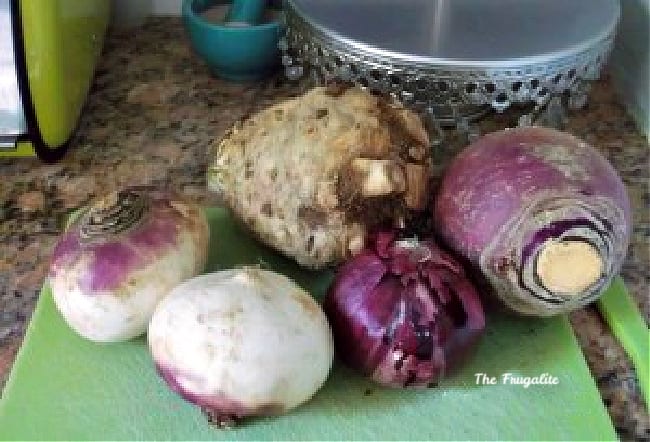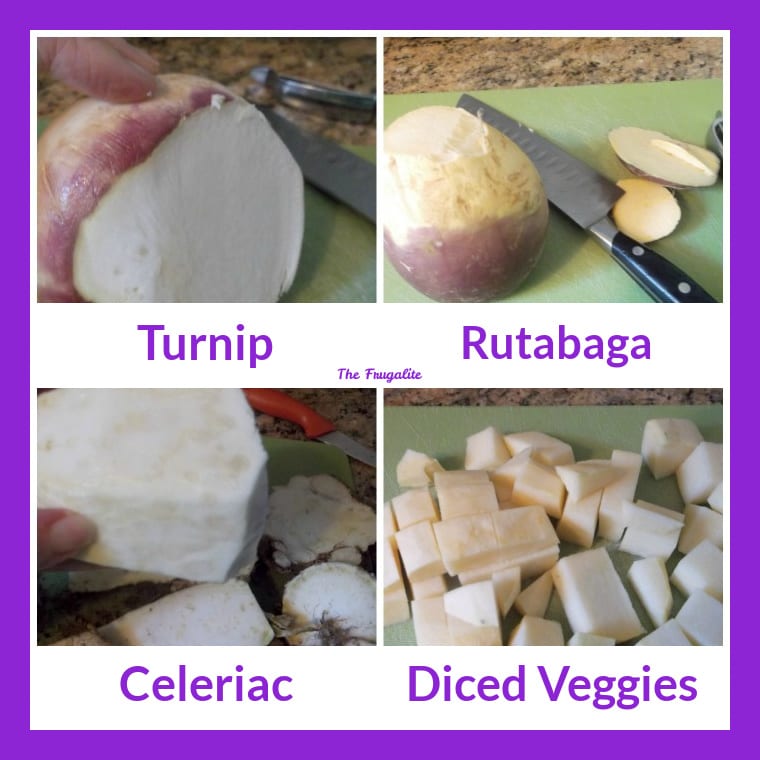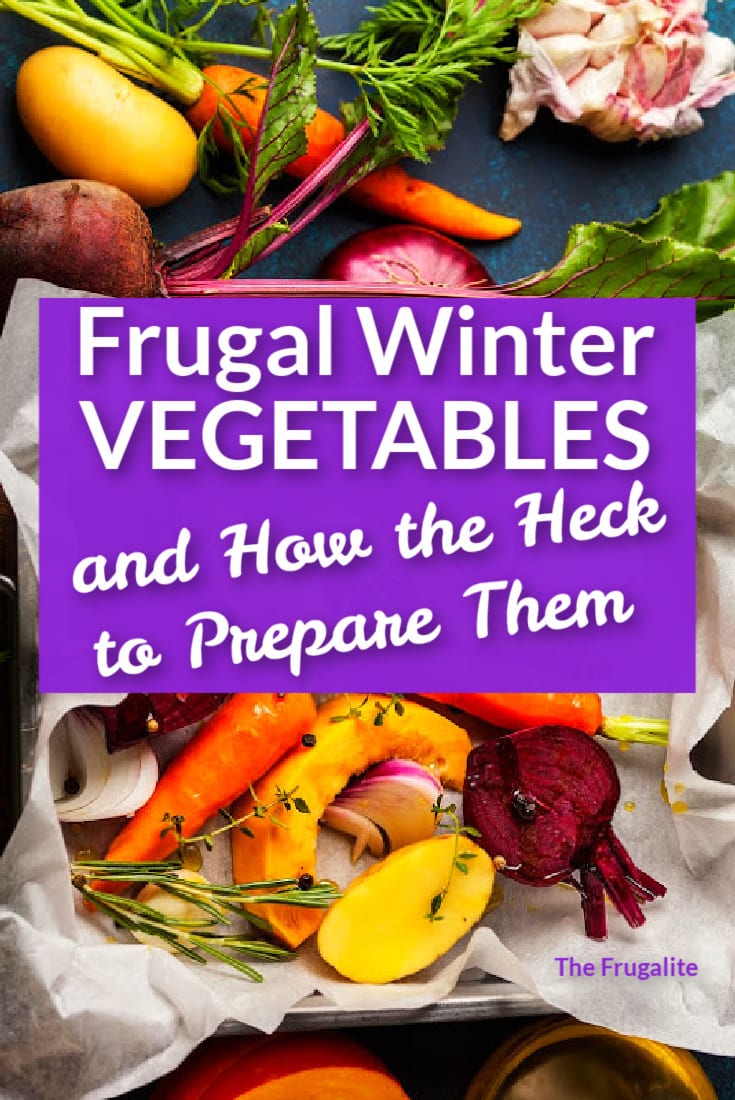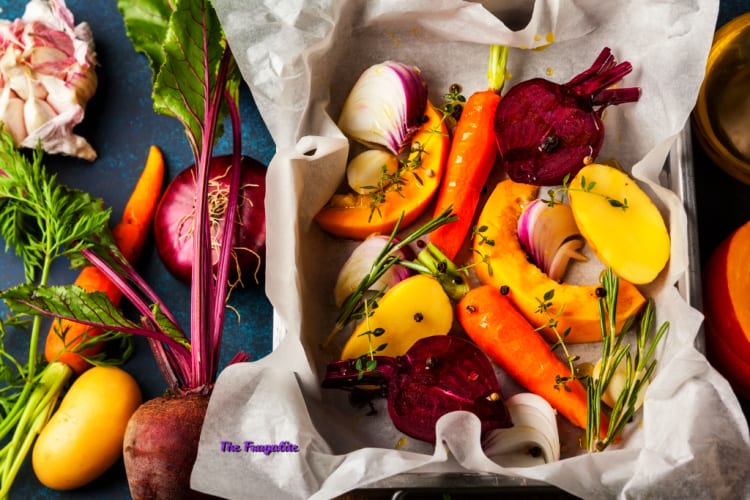(Psst: The FTC wants me to remind you that this website contains affiliate links. That means if you make a purchase from a link you click on, I might receive a small commission. This does not increase the price you’ll pay for that item nor does it decrease the awesomeness of the item. ~ Daisy)
By the author of The Ultimate Guide to Frugal Living and The Flat Broke Cookbook
Ask anyone who’s not a gardener what’s in season right now. Go ahead, I’ll wait here, because it won’t take long.
Did you get met with a blank stare and perhaps some mention of potatoes and onions? We’ve become so far removed from the land that most folks don’t even know what vegetables are in season this time of year. Because of our “food on demand” system, with food coming in from all corners of the globe, many people who don’t grow food have absolutely no idea what is growing on local farms right now. We live in a country where it doesn’t seem outrageous to serve asparagus and pumpkin in the same meal, followed up with blueberries for dessert. The people who are slaves to the grocery store can’t even fathom what people eat when they enjoy a local, seasonal diet.
But…what would our ancestors think of that combination? It’s not even close to being realistic since asparagus hits its peak in the early spring, blueberries come along midsummer, and pumpkin pulls up the rear, stubbornly waiting to ripen until fall.
It’s far healthier to eat food that is actually in season.
When you demand produce that is out of season, it’s coming from across the globe. This means that the items were picked before they were actually ripe, which means that the nutrients had not fully developed. The vitamins and minerals contained in produce begin to decrease the minute the food is picked. The harvested item immediately begins to die and decompose. By the time the food arrives at your local grocery store, it might already be 3 weeks old – and sometimes it’s even older than that.
What’s more, the packing plants take great pains to be sure that the fresh fruits that grace your table mid-winter look pretty. Many packagers add a waxy, glossy coating to the produce before shipping. The coating not only looks shiny and inviting, it slows down the decomposition of the fruit or vegetable. Some foods are sprayed with preservative chemicals, as well, to help them survive the arduous journey to your supermarket.
Reducing the distance your food travels isn’t the only health reason to eat seasonally. Nature provides certain foods at certain times because that is when your body needs them the most. They are also less likely to be drenched in pesticides, fertilizers and fungicides if the plants are growing as nature intended them too.
Right now, in the cold days of winter, you should consider eating more carbohydrates like those from root vegetables – they help the body to sustain a little more weight, which is needed to insulate against the cold weather. Warming vegetables like potatoes, cabbages, carrots, onions, rutabagas, and winter squash all store well in cool, dark places, providing energy and comfort throughout the winter season.
Adding more fish to your diet during this time of year is also beneficial for the warming effect, the higher calories, and the high levels of vitamin D (the vitamin you get directly from the sun during the warmer months). Vitamin D is important for good mental health and a strong immune system. Nuts, which store well for the winter, are loaded with Omega 3 fatty acids, which help moisturize your body from the inside out – this helps to fight that dry winter skin so many of us suffer from.
What’s in season right now?
The wide variety of climates means that there’s no one “in-season menu” that will be applicable to everyone. Eating locally in the winter is easier than you might think. You don’t have to go without fresh vegetables just because the snow is flying! Here are the vegetables you should focus on right now.
- Beets
- Broccoli
- Brussels sprouts
- Cabbage
- Carrots
- Cauliflower
- Celeriac
- Kale
- Onion
- Parsnips
- Potatoes
- Rutabaga
- Sweet potatoes
- Turnips
- Winter squash
How do you prepare winter vegetables?
If you hand some folks a rutabaga, they’ll have no idea what to do with it. Probably one of the most common reasons that people pass on the winter vegetables is because they don’t know how to prepare them. Invest in some great cookbooks for inspiration. I like Depression-era cookbooks for simple instructions on preparation, and there are some wonderful locavore cookbooks on the market that will teach you to turn these humble-looking veggies into mouth-watering treats.
Switch your salads to ones like coleslaw or broccoli salad and switch out your warm-weather greens for kale. Kale usually needs the addition of some sweetness – try adding honey to your salad dressing or tossing in a handful of dried cranberries.
Roasting your veggies brings out the sweet flavor while also warming up the house. Brussels sprouts, cauliflower, broccoli, and carrots can be roasted with garlic and olive oil for a nutritious side. My family also loves “oven fries” made from root vegetables.
Potatoes are always a welcome dish, whether they’re mashed, roasted, fried, or baked.
Winter vegetable substitutions
You can also make your regular dishes but substitute in some winter produce.
- Potato: Try sweet potato, parsnip, rutabaga, cauliflower, turnips, celeriac, or squash
- Summer squash: Try winter squash or rutabaga
- Romaine lettuce or baby spinach: Try kale or shredded cabbage
- Asparagus: Try broccoli or Brussels sprouts
- Carrots: Try parsnips or turnip slices
How do you cut up root vegetables?
You have a lumpy pile of unfamiliar produce on your cutting board. What the heck do you do with this?

Part of the reason people are hesitant to try new vegetables is because they honestly have no idea how to cook them. On the cutting board above, there are (clockwise, beginning at the left) turnips, celeriac, rutabaga, and, of course, onion. They’re rustic-looking, unfamiliar, and intimidating to some.
All of these are root vegetables, and with the exception of the onion, all can be treated just like a potato. You can mash them, slice them and fry them, add them to stew, puree them into a soup, or you can roast them.
Anytime you have a vegetable that is unfamiliar, the simplest way to deal with it is to slice off the ends so you can see what you have to work with. Then once you’ve seen the thickness of the skin, you can peel them using the most applicable method.

As you can see above, the turnip has the thinnest skin. You could use a vegetable peeler for that, but the skin of the rutabaga and celeriac will require a sturdy paring knife. Once the peel is off, you can cut these particular vegetables up the same way you would a potato – there isn’t a core of any type inside.
At this point, you can cut your unfamiliar vegetable in half to discern whether or not there’s a core to deal with. These particular vegetables can be treated the same way you would a potato – there isn’t a core of any type inside.
Here’s one of my favorite winter veggie recipes that you can alter with what you have on hand.
Some cookbooks you might like
- The Seasonal Kitchen Companion (This is a PDF with my family’s favorite season recipes, as well as instructions on how to preserve your goodies.)
- The Fannie Farmer Cookbook
- Cooking from the Farmers’ Market
- Earth to Table: Seasonal Recipes from an Organic Farm
What are your favorite winter veggies?
What are your favorite vegetables to prepare right now? What’s your favorite way to cook them? Share your best winter produce tips and meal ideas in the comments.
About Daisy
Daisy Luther is a coffee-swigging, adventure-seeking, globe-trotting blogger. She is the founder and publisher of three websites. 1) The Organic Prepper, which is about current events, preparedness, self-reliance, and the pursuit of liberty; 2) The Frugalite, a website with thrifty tips and solutions to help people get a handle on their personal finances without feeling deprived; and 3) PreppersDailyNews.com, an aggregate site where you can find links to all the most important news for those who wish to be prepared. Her work is widely republished across alternative media and she has appeared in many interviews.
Daisy is the best-selling author of 5 traditionally published books, 12 self-published books, and runs a small digital publishing company with PDF guides, printables, and courses at SelfRelianceand Survival.com You can find her on Facebook, Pinterest, Gab, MeWe, Parler, Instagram, and Twitter.












9 thoughts on “Frugal Winter Vegetables and How the Heck to Prepare Them”
Butternut squash and broccoli cheese soups. Recipes abound on AllRecipes.com
I love the rich fall veggies. My dad loved the root vegetables roasted then served with a dark brown gravy. I love them with a splash of balsamic vinegar and sea salt. Pumpkins and winter squash are great roasted “baked” cut up, clean out seeds and season as desired. I like a simple mix of real butter and a little brown sugar and a sprinkle of salt. Pumpkins or darker fleshed winter squash can be cut up and boiled of steaned also. Then scrape free of the thick skin and mash or puree to make pies, puddings, et. Spaghetti squash is good split lengthwise and remove seeds. Then bake or steam till tender. Use
fork to remove the long stringy flesh Then prepare and serve like pasta because its spaghetti like texture and neutral flavor it’s a good vehicle for flavorful sauces. Also pretty good baked with tiny halved tomatoes and herbs. Top with cheeses.
Good recipes abound.
These heavier vegetables are great oven roasted or baked. A perfect time of year to use your oven.
I just had some squash – could have used the oven but ten minutes in the microwave cooked it just as well and probably used less energy. I had some plain and some cut up with nutritional yeast sprinkled on it. Quite good. (I’m watching my calories or I would have had it with black pepper and butter)
I did a permaculture course , and we were already eating seasonal because it’s cheaper to eat in season foods. But trying to produce a large percentage of your food in pots in a rental was a struggle. It really showed me how much we eat effortlessly. It takes so much energy to produce the food you eat. It reduced our portion sizes and made us stick to eat in season. Another bonus was everything tasted so much better , more full of flavour as it was ripe properly due to being in season. We are in summer now but for winter, we did some baked , loads of soups and casseroles. (If in doubt hide the veggie in a casserole for fussy kids)
Well done!!
Great article!!
Thanks so much!!
This sounds weird but is delicious. Peel the turnip and slice it up raw with some peanut butter spread on the slice. The amish lady at the farm stand where I bought the turnips let me in on that tip.
We just had butternut squash soup, and this week my wife is making roasted cauliflower soup. They’re a great starter and even the kids like them (so I know they’re getting more veggies in their diet).
Thanks!
The Swedes prepare “Rotmas” or mashed root vegetables. Rutabagas, carrots and potatoes all cooked and mashed together.